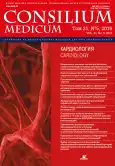The rate of symmetric complex anatomy of the arms’ arteries in the conversion from the right to the left radial approach, assessed by the data of the open registry COMPAAS (COMPlex Anatomy of Arteries and Symmetry)
- Authors: Semitko S.P.1, Melnichenko I.S.2, Karpeeva M.I.3, Bolotov P.A.4, Analeev A.I.2, Azarov A.V.1, Kruk S.V.4, Klimov V.P.4, Sorokin V.V.4, Ioseliani D.G.1
-
Affiliations:
- I.M. Sechenov First Moscow State Medical University (Sechenov University)
- Mytishchi City Clinical Hospital
- NORBIT
- V.V. Veresaev City Clinical Hospital
- Issue: Vol 21, No 5 (2019)
- Pages: 92-98
- Section: Articles
- URL: https://journals.rcsi.science/2075-1753/article/view/96856
- DOI: https://doi.org/10.26442/20751753.2019.5.190429
- ID: 96856
Cite item
Full Text
Abstract
Full Text
##article.viewOnOriginalSite##About the authors
Sergei P. Semitko
I.M. Sechenov First Moscow State Medical University (Sechenov University)D. Sci. (Med.), Prof. Moscow, Russia
Ilia S. Melnichenko
Mytishchi City Clinical Hospital
Email: ilyamel55@gmail.com
doctor for endovascular diagnosis and treatment Mytishchi, Russia
Marina I. Karpeeva
NORBIT
Email: kamarik@list.ru
Head of software development Department Moscow, Russia
Pavel A. Bolotov
V.V. Veresaev City Clinical Hospital
Email: dr.bolotov@mail.ru
D. Sci. (Med.), Prof. Moscow, Russia
Anton I. Analeev
Mytishchi City Clinical Hospital
Email: anton-analeev@yandex.ru
Head of Department Mytishchi, Russia
Aleksei V. Azarov
I.M. Sechenov First Moscow State Medical University (Sechenov University)
Email: azarov_al@mail.ru
Cand. Sci. (Med.) Moscow, Russia
Sergei V. Kruk
V.V. Veresaev City Clinical Hospital
Email: kruksergey1889@gmail.com
doctor for endovascular diagnosis and treatment Moscow, Russia
Vitalii P. Klimov
V.V. Veresaev City Clinical Hospital
Email: vp_klimov@mail.ru
Cand. Sci. (Med.) Moscow, Russia
Vladimir V. Sorokin
V.V. Veresaev City Clinical Hospital
Email: voldemar86@list.ru
doctor for endovascular diagnosis and treatment Moscow, Russia
David G. Ioseliani
I.M. Sechenov First Moscow State Medical University (Sechenov University)
Email: davidgi@mail.ru
D. Sci. (Med.), Prof., Acad. RAS Moscow, Russia
References
- Moscucci M. Grossman. Baim’s Cardiac Catheterization. Angiography, and Intervention.Philadelphia: Lippincott Williams and Wilkins, 2013. 8th edition.
- Spencer B. King III. The development of Interventional Cardiology. J Am Coll Cardiol 1998; 31 (4; Suppl. 2): 64B-88B.
- Nasser T.K, Mohler E.R 3rd, Wilensky RL et al. Peripheral vascular complications following coronary interventional procedures. Clin Cardiol 1995; 18: 609-14.
- Doyle B.J, Ting H.H, Bell M.R et al. Major femoral bleeding complications after percutaneous coronary intervention: incidence, predictors, and impact on long-term survival among 17,901 patients treated at the Mayo Clinic from 1994 to 2005. JACC Cardiovasc Interv 2008; 1: 202-9. doi: 10.1016/j.jcin.2007.12.006
- Eikelboom J.W, Mehta S.R, Anand S.S et al. Adverse impact of bleeding on prognosis in patients with acute coronary syndromes. Circulation 2006; 114: 774-82. doi: 10.1161/CIRCULATIONAHA.106.612812
- Yatskar L, Selzer F, Feit F et al. Access site hematoma requiring blood transfusion predicts mortality in patients undergoing percutaneous coronary intervention: data from the National Heart, Lung, and Blood Institute Dynamic Registry. Catheter Cardiovasc Interv 2007; 69: 961-6. doi: 10.1002/ccd.21087
- Campeau L. Percutaneous radial artery approach for coronary angiography. Cathet Cardiovasc Diagn 1989; 16: 3-7.
- Kiemeneij F, Laarman G.J. Percutaneous transradial artery approach for coronary stent implantation. Cathet Cardiovasc Diagn 1993; 2: 173-8.
- Hussain A, Kaul U. RadIal Vs Femor A.L (RIVAL) trial for coronary angiography and intervention in patients with acute coronary syndromes. Indian Heart J 2012; 64 (1): 114-5. doi: 10.1016/S0019-4832 (12) 60036-4
- Valgimigli M, Gagnor A, Calabro P et al. Radial versus femoral access in patients with acute coronary syndromes undergoing invasive management: a randomised multicentre trial. Lancet 2015; 385: 2465-76. doi: 10.1016/S0140-6736 (15) 60292-6
- Bernat I et al. ST-segment elevation myocardial infarction treated by radial or femoral approach in a multicenter randomized clinical trial: the STEMI-RADIAL trial. J Am Coll Cardiol 2014; 63: 964-72.
- Sandhu K, Nadar S.K. Percutaneous coronary intervention in the elderly. Int J Cardiol 2015; 199: 342-55. doi: 10.1016/j.ijcard.2015.05.188
- Cox N, Resnic F.S, Popma J.J et al. Comparison of the risk of vascular complications associated with femoral and radial access coronary catheterization procedures in obese versus nonobese patients. Am J Cardiol 2004; 94: 1174-7. doi: 10.1016/j.amjcard.2004.07.088
- Schoenfeld M.S, Kassas I, Shah B, Transradial Artery Eccess in Percutaneous Coronary Intervention for ST - Segment Elevation Myocardial Infarction and Cardiogenic Shock. Curr Treat Options Cardiovasc Med 2018; 20 (2): 11. doi: 10.1007/s11936-018-0607-1
- Jabara R, Gadesam R, Pendyala L et al. Ambulatory discharge after transradial coronary intervention: Preliminary US single-center experience (Same-day TransRadial Intervention and Discharge Evaluation, the STRIDE Study). Am Heart J 2008; 156: 1141-6. doi: 10.1016/j.ahj.2008.07.018
- Cooper C.J, El-Shiekh R.A, Cohen D.J et al. Effect of transradial access on quality of life and cost of cardiac catheterization: A randomized comparison. Am Heart J 1999; 138: 430-6.
- Roffi M, Patrono C, Collet J.P et al; ESC Scientific Document Group. 2015 ESC guidelines for the management of acute coronary syndromes in patients presenting without persistent ST-segment elevation: Task Force for the Management of Acute Coronary Syndromes in Patients Presenting without Persistent ST-Segment Elevation of the European Society of Cardiology (ESC). Eur Heart J 2016; 37: 267-315.
- Numasawa Y, Kawamura A, Kohsaka S et al. Heart Vessels 2014; 29: 49. https://doi.org/10.1007/s00380-013-0324-3
- Tröbs M et al. Predictors of Technical Failure in Transradial Coronary Angiography and Intervention. Am J Cardiol 2017; 120 (9): 1508-13. doi: 10.1016/j.amjcard. 2017.07.049
- Матчин Ю.Г., Атанесян Р.В., Басинкевич А.Б. и др. Первые результаты применения новой методики - локтевого артериального доступа - для проведения диагностической коронарографии и эндоваскулярного лечения коронарных артерий. Диагностическая и интервенционная радиология. 2012; 6 (2): 67-78. @@Matchin Iu.G., Atanesian R.V., Basinkevich A.B. et al. Pervye rezul'taty primeneniia novoi metodiki - loktevogo arterial'nogo dostupa - dlia provedeniia diagnosticheskoi koronarografii i endovaskuliarnogo lecheniia koronarnykh arterii. Diagnosticheskaia i interventsionnaia radiologiia. 2012; 6 (2): 67-78
Supplementary files






